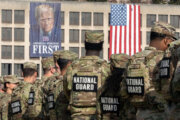A country’s high expenditures on its military doesn’t ensure a perceived high quality of life.
Only Germany is among the top 10 military spenders by total dollar amount that also ranks among the top 10 countries seen to offer a high quality of life, according to a comparison of data from the 2018 Best Countries and the Sweden-based Stockholm International Peace Research Institute, or SIPRI.
Differing ways that countries employ their armed forces complicates comparing military spending with other government investments. The countries ranking highest in perceived quality of life are mostly outside of the top 20 military spenders. The Best Countries quality of life rankings are based on the scores of nine attributes derived from an annual survey of more than 21,000 people around the world. A total of 80 countries were evaluated in the Best Countries survey.
| Country | SIPRI Mil. Spending Rank | BC Quality of Life Ranking (2018) | BC Power Ranking (2018) | BC Overall Ranking (2018) | SIPRI Mil. Spending of GDP (2017) |
| United States | 1 | 17 | 1 | 8 | 3.10% |
| China | 2 | 21 | 3 | 20 | 1.90% |
| Saudi Arabia | 3 | 41 | 9 | 37 | 10.30% |
| Russia | 4 | 38 | 2 | 26 | 4.30% |
| India | 5 | 32 | 15 | 25 | 2.50% |
| France | 6 | 16 | 6 | 9 | 2.30% |
| U.K. | 7 | 13 | 5 | 4 | 1.80% |
| Japan | 8 | 14 | 7 | 5 | 0.90% |
| Germany | 9 | 10 | 4 | 3 | 1.20% |
| South Korea | 10 | 24 | 11 | 22 | 2.60% |
Some top military spenders fared comparatively well in the quality of life ranking. The U.K., Japan and France ranked 13th, 14th and 16th, respectively, for a ranking that factors in attributes such as its job market, having well-developed public education and health care systems and a general sense of stability.
Other nations with expensive military budgets fall short in the overall quality of life rankings, including Russia at No. 38 and Saudi Arabia at No. 41, with the U.S. and China — the world’s top military spenders — at Nos. 17 and 21, respectively.
Some experts draw a clear connection between the military spending and quality of life.
“The reason (these countries ) have high qualities of life is because they do not spend high amounts on military spending,” says Mary Kaldor, an expert in global governance and director of the London School of Economics’ Civil Society and Human Security Research Unit.
Canada, ranked No. 1 for quality of life, is 14th for military spending. The other countries seen to offer the highest qualities of life — Denmark, Sweden and Norway — are outside the top 30 countries for military spending. New Zealand, ranked ninth in quality of life, ranks 56th for military spending , and Luxembourg, at 12th for quality of life, ranks 102nd for military spending.
| Country | BC Quality of Life Ranking (2018) | SIPRI Mil. Spending Rank | BC Power Ranking (2018) | BC Overall Ranking (2018) | SIPRI Mil. Spending of GDP (2017) |
| Canada | 1 | 14 | 12 | 2 | 1.30% |
| Denmark | 2 | 43 | 27 | 11 | 1.20% |
| Sweden | 3 | 34 | 19 | 6 | 1.00% |
| Norway | 4 | 30 | 26 | 12 | 1.60% |
| Australia | 5 | 13 | 16 | 7 | 2.00% |
| Switzerland | 6 | 38 | 17 | 1 | 0.70% |
| Finland | 7 | 47 | 42 | 14 | 1.40% |
| Netherlands | 8 | 23 | 21 | 10 | 1.20% |
| New Zealand | 9 | 56 | 35 | 13 | 1.20% |
| Germany | 10 | 9 | 4 | 3 | 1.20% |
“I think it’s very easy. It’s because they spend less on the military so they can spend more on public services,” Kaldor adds. “And it’s not just about spending more on public service, it’s also the way in which the pressures of the defense industry distort politics. That makes it much more difficult for politicians to support public services.”
Others believe other factors are more influential than quality of life attributes in people’s lives.
“I suspect the link in terms of the high military spending is probably due to the state of the economy more than anything else,” says James Chin, director of the University of Tasmania’s Asia Institute in Australia. “If you spend a lot of money in the military, sustaining a large military complex with salaries, et cetera, it’s a large component of the economy in terms of consumer spending.”
A Longstanding Debate
The debate regarding how a government should balance military spending and domestic services dates back at least a century. William Jennings Bryan supposedly coined the phrase “guns and butter” to sum it up when he resigned as U.S. secretary of state in 1915 due to what he considered President Woodrow Wilson’s anti-German stance that would drag the U.S. into war.
The industrial complex surrounding military spending has since grown exponentially, particularly following World War II, and now operates as a signature form of trade and diplomacy for countries that manufacture weapons of war. The U.S. — the world’s largest arms exporter — shipped more than $12 billion in weapons in 2017 to allies and partners, according to SIPRI. Russia exported $6 billion and France $2 billion.
Many in the U.S. Defense Department argue that the strength of the American military protects the post-World War II system of global order that deters other countries from waging war with others.
A look at safety, one of the attributes used to develop the Best Countries Quality of Life rankings, offers a window into the complexity of connecting a country’s military spending and the quality of citizens’ lives.
Both Pakistan and Singapore, for example, spend roughly $10 billion per year on their militaries, roughly 3.5 percent of their GDPs. Yet Singapore, a city-state known as one of the world’s safest societies, ranks 18th for Quality of Life, while Pakistan, wracked by terrorist violence and regional instability, is at 71.
[SEE: The 10 Countries With the Best Quality of Life for Expats]
These two countries employ their militaries in opposing ways. The Pakistani armed forces, particularly its highly influential Inter-Services Intelligence or ISI, is practically enmeshed in its civilian government, and has waged multiple coups during its 70-year history. However, Singapore founded its military off the British army and modeled it with heavy input from Israel. Like the Jewish state, it requires military service, meaning a military uniform is not out of place in any of its communities, unlike in Pakistan.
“In Pakistan people are concerned about the military. It plays a very active role in domestic politics,” Chin says. “In Singapore, the military does not play a role in domestic politics. That’s always been the case, from the British tradition. The civilians have the final say.”
Pakistan, a nuclear power, also faces what its government considers existential threats from neighboring rival India, also a nuclear power, and instability from its other neighbor, Afghanistan. Singapore resides in a much more stable neighborhood.
Elsewhere, both Russia and South Korea spend roughly 12 percent of their total government budget on their militaries, yet Russia is considered the world’s second-most powerful country while South Korea is 11th on that list.
“Countries spend on the military what they consider necessary according to their perception of their security situation,” says Julian Cooper, a former professor at the University of Birmingham and an expert in international military expenditures. “Russia considers itself surrounded by their potential enemies. South Korea has the umbrella of U.S. protection. No mystery here at all, just entirely rational behavior.”
Russia also has a history as a superpower during the Cold War, and aspires under President Vladimir Putin to return to that status. South Korea, meanwhile, is for the first time emerging as an aspiring global power as it seeks to exploit its partnership with the U.S. to offset ambitious neighbors like China.
Geography also is a factor. Countries in Northern Europe aside from Britain, France and Germany can afford to invest less in their militaries knowing that blocs and alliances such as the EU and NATO will ensure their collective security. That’s less true in Saudi Arabia, some say, which faces extremist threats from nearby wars in Syria, Iraq and Afghanistan, and Iranian-backed enemies like Hezbollah in Lebanon and the Houthis in Yemen.
“I think it’s perfectly understandable why Saudi Arabia would spend a higher percentage of its budget on defense compared to Scandinavian countries, for example,” says Fahad Nazer, a consultant to the Saudi Embassy in Washington, D.C. “The latter live in a considerably more stable region.”
Nazer, who says he does not speak on behalf of the embassy, points to Saudi Crown Prince Mohammed bin Salman’s acknowledgement of the need to improve the quality of life for Saudis, and his Vision 2030 goal to revitalize the domestic economy and solidify new rights for its citizens — including allowing women to drive.
[MORE: The 5 Longest-Serving World Leaders Still in Power]
Yet other examples cast doubt on clear connections between a country’s military spending and its quality of life, or even its ability to exert power.
Costa Rica and Panama, for example, have abolished their standing armies and spend nothing on militaries. They rank 45th and 48th overall in the U.S. News rankings, and 47th and 55th in overall qualities of life.
“People have very old-fashioned perceptions of power. I don’t think military spending is very important in terms of power,” says Kaldor of the London School of Economics. “High military spending usually indicates you spend a lot on very sophisticated weapons systems that are quite good for destruction but not quite so good for exerting power. The U.S. has been hugely destructive over ISIS, but it’s basically razed all these places to the ground, and yet it has very little power on the ground in Syria.”
“The tangible threat that ordinary people in the U.S. face include gun violence and racism. Nobody expects Russia to invade America, do they? And Russia may be interfering, but military spending isn’t the way you get Russia to stop interfering in elections.”
More from U.S. News
Data: Americans Consider China, Russia More Powerful Than U.S.
The 10 Countries With the Best Quality of Life for Expats
The 5 Longest-Serving World Leaders Still in Power
Does a Country’s Military Spending Improve Quality of Life? originally appeared on usnews.com







